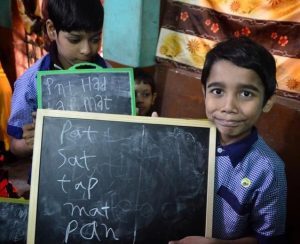About the area
Topsia is a neighbourhood in eastern Kolkata, bordered to the east by the Eastern Metropolitan Bypass and to the north by its approach road. The area is also bisected by a wide drainage canal.
It is a densely populated area of mixed housing ranging from high rise blocks to squatter settlements, although some are illegal constructions. Residents face inadequate facilities, particularly in terms of water supply and sanitation. The narrow lanes are often congested with traffic, which worsens the air pollution.
Topsia and the neighbouring area of Tangra are the heart of the leather industry in the city. The various processes involved in the manufacture of leather emit a pervasive smell and contribute to poor air quality.
The population of Topsia is about 500,000 (200,000 families), of which over 100,000 are children. About 90 per cent of the families are Muslim and the remainder Hindu.
This is generally a poor community with many families living in single rooms. Working men tend to earn a meagre living as wage labourers, but there are also jobs in the leather factories and local trades. Some of the leather factories employ children to do fine and detailed work; typically they come from the poorest families and work long hours in dangerously cramped conditions.
Literacy levels are generally very low among women. Most women spend their time caring for their children and running the household but health problems are common place, particularly chronic asthma from indoor air pollution. Some women suffer abuse from their husbands.
About the local organisation and history of CRS involvement
The local community organisation is the Topsia Taj Club. In 2004 Mrs Rabia Begum, a teacher, approached club members and proposed starting an education programme for the underprivileged children of the area. After several years of success, a skill training programme for older girls and women was added in 2007. CRS started working with this organisation in 2005 and currently supports about 250 families through education and healthcare programmes.
Current CRS programmes
 The education programme is targeted at pre-primary children (age 3 to 4). 55 children attend the sessions. The curriculum is based on ‘joyful learning’ methods and there is an emphasis on dance, music and drawing. The aim is to give the children a good start in the basics of reading and writing so that they can be mainstreamed into government primary schools. CRS helps each child to open a bank account and they are encouraged to save money.
The education programme is targeted at pre-primary children (age 3 to 4). 55 children attend the sessions. The curriculum is based on ‘joyful learning’ methods and there is an emphasis on dance, music and drawing. The aim is to give the children a good start in the basics of reading and writing so that they can be mainstreamed into government primary schools. CRS helps each child to open a bank account and they are encouraged to save money.
An Under 10s football team has been established which plays matches against teams from other CRS Education Centres.
The health programme is a combination of clinical and preventive medicine. It caters for the children through school clinics and for the wider community through general health check-ups and the distribution of medicines. The visiting doctor can also make referrals to government hospitals and diagnostic services. A particular problem in the community is iron deficiency anaemia and those children and women suffering receive iron supplements. Awareness programmes on issues relating to health and hygiene aim to educate the community and prevent ill-health. Health camps are also held in collaboration with other agencies targeting particular health issues.
Success stories
“Nisha was diagnosed with thalassemia when she was 3 years old. We did not know about this condition before. Her treatment was really expensive for us to afford but we have been able to manage to give her blood transfusions from the local government hospital. Nisha becomes very weak after each transfusion but the only thing she looks forward to going to school. The teacher takes special care of her and she loves saying her rhymes and playing with her friends. I hope she is able to continue her education as far as possible.”
– Samira Khatoon, mother of Nisha Khatoon, student at Topsia school
“I am a rickshaw puller. My wife works as a domestic help. We live in Topsia. When my daughter Khushboo first started trying to walk she had some problems but we just thought it was normal. But then she was diagnosed with polio, the disease that causes muscle weakness. She was prescribed orthosis – a leg and foot brace – to give support and prevent deformities. But we are very poor people and could not afford this expensive medical equipment. When we took Khushboo to a CRS health clinic at Topsia Taj Sports Club they immediately helped us by making a referral to the Rehabilitation Centre for Children. Khushboo has been receiving treatment and can now proudly stand on her own feet and is slowly learning to walk independently.”
– Noor Ali, father of Khushboo Khatoon
Support is needed to continue the work in the community at Topsia. This includes provision of education materials, midday meals and a teacher’s honorarium for the school; medicines and equipment for the health clinic; and training materials for the women’s empowerment programme.
